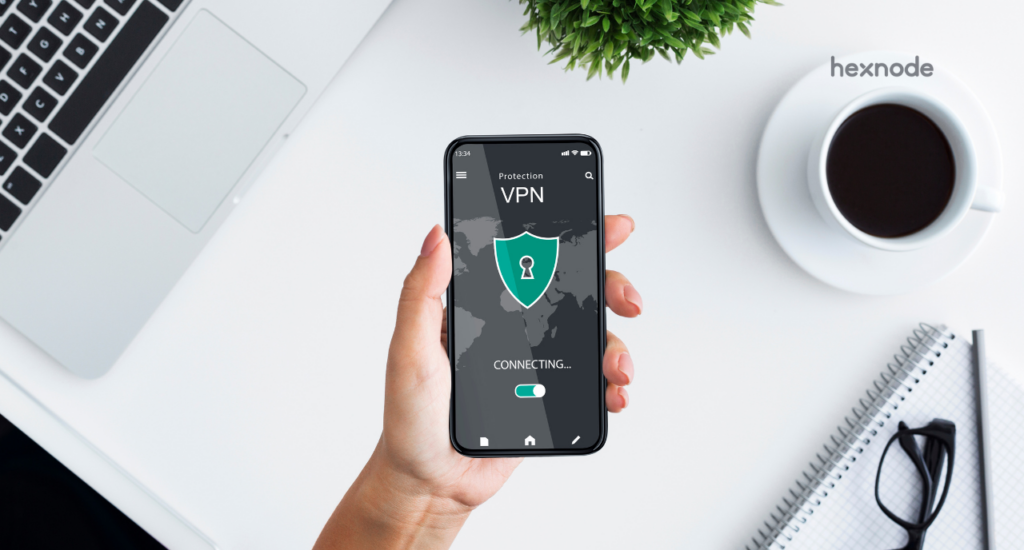VPN or Virtual Private network is a tool that everyone uses these days. Many people confuse VPN with VPN protocols. Well, guess what, they are not the same thing. So, what is the difference between a Virtual Private Network (VPN) service and a VPN protocol?
A VPN service or provider makes a secure tunnel between your device and the internet. All your requests are first sent to a server owned by the VPN provider and then to the website’s server. As a result, your device information, particularly your IP address, is hidden, and the website receives only the IP address of the VPN server.
A VPN protocol is a specified set of rules on how the tunnel is formed and how data is transferred securely. It is based on these protocols that the VPN providers secure and anonymize user data accessed over the internet.
- Which VPN protocol should you choose?
- How do VPN protocols work?
- Some common VPN protocols explained
- Point-To-Point Tunneling Protocol (PPTP)
- Secure Socket Tunneling Protocol (SSTP)
- Layer 2 Tunnel Protocol (L2TP) with Internet Protocol Security (IPSec)
- Internet Key Exchange Version 2 (IKEv2)
- OpenVPN
- WireGuard
- SoftEther
- Custom Protocols
- In conclusion,
Which VPN protocol should you choose?
Choosing a VPN protocol specific to your needs is a very tough job. This is because the two main factors considered while choosing a VPN protocol, that is, speed and security, are contradictory.
If you choose a VPN protocol that ensures swift internet speed, then the security structure might not be great. Similarly, if you choose a VPN protocol that ensures high security then the internet speeds might not be great. So, before choosing a protocol you must prioritize your requirements. After that, you can choose a VPN protocol that suits your needs the best.
How do VPN protocols work?
As mentioned earlier VPN protocols decide how your data is to be secured and how your data is to be tunneled. Each VPN protocol has a different way of working and approaches data security differently.
Even though different protocols function differently, there are two basic processes to the working of each VPN protocol: authentication and encryption.
Authentication refers to the process of making sure that your device is communicating with a trusted VPN server. Without authentication, there is a slight possibility that a man-in-the-middle attack might occur where your device might get connected to an untrusted or unsafe server.
Encryption refers to the process of securing your data by scrambling it into an unreadable format. This can be unscrambled only using an encryption key. There are different algorithms used for encryption and different algorithms provide different levels of security.
Each VPN protocol has a different combination of authentication and encryption. As the combination differs, levels of security and browsing speeds also differ. Also, different protocols have different rules and ways to approach potential errors, which affects the stability and reliability of the VPN.
Some common VPN protocols explained
A lot of VPN protocols are now available. Some of the most commonly used VPN protocols are:
Point-To-Point Tunneling Protocol (PPTP)
PPTP is one of the oldest protocols and was introduced by Microsoft. There are 2 sides to being one of the oldest connections. One is since it has been around for a long time, it is compatible with almost all devices out there. The second side is that the protocol has a lot of vulnerabilities and hackers can easily break the protocol.
As the protocol doesn’t use any advanced security structures, it provides great browsing speeds and stable connections. PPTP uses a basic 128-bit encryption, which offers no additional security benefits. So, it is advisable to stay away from PPTP even though it provides a swift stable connection.
Secure Socket Tunneling Protocol (SSTP)
SSTP is also a VPN protocol developed by Microsoft, mainly aimed at securing networks accessed from Windows-powered devices. Even though the SSTP was initially introduced for Windows devices, now almost all leading operating systems provide support for SSTP. This doesn’t mean that it is easy to set it up on non-Windows devices.
When it comes to authentication and encryption, SSTP is way better than PPTP. SSTP uses a 256-bit SSL key for data encryption and 2048-bit SSL or TLS certificates for authentication. A major advantage of SSTP is that it can easily bypass firewalls. So SSTP is perfect for Windows users as it is an in-built feature for Windows devices. SSTP is not as fast as PPTP but way more secure than PPTP.
Layer 2 Tunnel Protocol (L2TP) with Internet Protocol Security (IPSec)
L2TP is a tunneling protocol that is used along with IPSec. This is because L2TP doesn’t include the encryption of data in the protocol itself and has to seek help from other security structures, mainly IPSec for data encryption.
How these combinations work is very simple. The L2TP secures the connection between two points and IPSec encrypts the data that is being transferred between the two points. Since this uses two protocols, the data is encapsulated twice and this causes the connection to slow down a bit.
When compared to the above-mentioned protocols, L2TP is a lot more secure than PPTP and slightly more secure than SSTP, but when it comes to speed L2TP is significantly slower than PPTP and pretty close to, if not slightly slower than, SSTP.
Compatibility-wise L2TP is easy to set up in almost all devices, as most of the leading operating systems support the use of L2TP. The only issue that might come up is when there is a firewall because L2TP can’t bypass firewalls as easily as SSTP.
Internet Key Exchange Version 2 (IKEv2)
IKEv2 is very similar to L2TP in the sense that this protocol also does not provide any type of data encryption and uses IPSec for data encryption. IKEv2 was introduced by Microsoft along with Cisco. IPSec uses secure encryption protocols such as AES, Camellia, or ChaCha20 with a 256-bit key.
The working is also similar to L2TP, first, the IKEv2 ensures a secure connection between two different points and IPSec encrypts the data being transferred between these two points. The main advantage of IKEv2 is that the protocol ensures a very stable connection even if the network type is switched.
IKEv2 is very popular among people who use mobile devices. IKEv2 is not only secure but also provides decent connection speeds. The main drawback to this protocol is that it is not compatible with a lot of devices. So, setting it up might be a slight issue.
OpenVPN
OpenVPN was introduced back in 2001 and it is considered one of the most secure VPN protocols out there. OpenVPN is an open-source VPN protocol, meaning its source can be accessed and checked by literally anyone.
Even though OpenVPN has been around for a long time and it is an open-source protocol, there are no known major vulnerabilities to it. OpenVPN can use a variety of technologies for data encryption like AES, Blowfish, and ChaCha20. It also makes use of a 2048-bit RSA certificate for authentication.
Since it is an open-source project, users can configure it according to their specific needs. It is also compatible with almost all platforms out there. Some of the major platforms that support OpenVPN include Windows, macOS, Android, iOS, and Linux.
There are 2 types of OpenVPN based on the type of communication protocols used, namely OpenVPN TCP (Transmission Control Protocol) and OpenVPN UDP (User Datagram Protocol). In the case of TCP, a connection has to be made between the sender and receiver of data, whereas in UDP, no such channel or connection is made.
UDP is much faster compared to TCP, this is because the data packets are not checked while it is being transferred. TCP on the other hand provides a more secure connection. Whether it is TCP or UDP, OpenVPN isn’t as fast as most other protocols. So, if data security and privacy are your main concerns, then you should always try to use OpenVPN if possible.
WireGuard
WireGuard is a relatively new VPN protocol. It is an open-source protocol, just like OpenVPN but it is designed to perform better. Compared to OpenVPN, WireGuard is much more condensed in terms of code length.
Released in 2019, WireGuard was found to outperform OpenVPN in speed and bandwidth usage. As for data security and encryption, WireGuard does not support older systems like AES but instead uses newer technology like ChaCha20. ChaCha20 is considered to be much faster compared to AES.
A minor concern regarding WireGuard is that VPN servers keep a temporary log of the user’s IP address. This can be dangerous if not safeguarded properly. Also, WireGuard is not that great at bypassing firewalls. So, if you are okay with a relatively new VPN that promises high safety with great internet speeds, then WireGuard is the way to go.
SoftEther
SoftEther is also a relatively new open-source VPN protocol that was released in the mid-2010s. Just like WireGuard, SoftEther also provided great security without compromising much on the speed department.
SoftEther uses varieties of 256-bit ciphers for data encryption, which includes AES. As for authentication, SoftEther makes use of protocols like OpenSSL.
In 2018, SoftEther had a security audit, and researchers found a few minor vulnerabilities associated with it. Among the vulnerabilities, it was found that SoftEther was susceptible to man-in-the-middle attacks. This is because SoftEther doesn’t verify the user’s certificate by default.
So, SoftEther is a very good option just like WireGuard, offering great data security and privacy without decreasing internet speeds. Keep in mind that always opt for verification of certificates while using SoftEther.
Custom Protocols
As more and more VPN providers came to the surface, they started making their own protocols rather than using the already existing ones. The problem with these protocols is that they are not open source. So, it is hard to find if there are any vulnerabilities or not.
In conclusion,
There are a lot of VPN protocols and VPN providers out there and new ones are popping up each day. So, while choosing a VPN solution suitable for your use, make sure that the VPN provider and protocol satisfy all your needs. Also be careful while choosing a VPN, as a lot of scams and fake VPN providers are out there that can leak your data to unwanted sources.
When considering data security, VPN is just the bare minimum you can do. There are a lot of new technologies like Zero Trust Network Access (ZTNA), Software-defined perimeter (SDP), and Secure Access Service Edge (SASE) which can be used along with or instead of VPN which will provide a higher level of data security.
Sign up for a free trial
Sign up for a free 14-day trial and explore the network security features offered by Hexnode
Sign up




